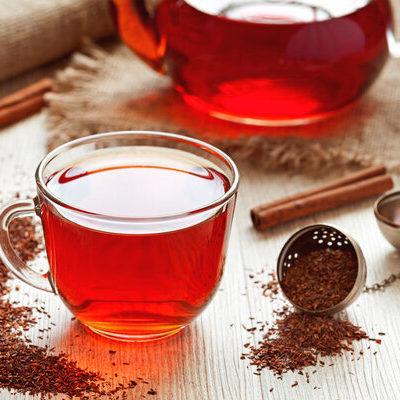
Red Tea
What is Red Tea?
Red tea is a caffeine-free herbal tea. It is also known as rooibos tea or red bush tea. South Africa has been the only country producing red tea for centuries.
- This tea comes in two varieties, which are rooibos and green rooibos.
- Rooibos has a red color because it is fully oxidized, unlike green rooibos.
In 2020, the worldwide tea market generated a revenue of $199,382.9 million.
The top five rooibos tea brands, according to Sibo Survivor, are:
- Organic Rooibos Red Tea
- Organic Rooibos Tea
- Rooilife Rooibos
- My Red Tea Rooibos
- Positively Tea Caramel Rooibos
Origin of red tea
This tea plant grows in a specific region in South Africa. For years, natives in the region used the leaves as an herbal remedy to treat certain diseases. As the native tribes’ population dwindled, the knowledge of the tea leaves’ existence decreased. Carl Humberg, a botanist, rediscovered the leaves again in 1772, which led to their resurgence in popularity. In 1904, a Russian immigrant with connections to the tea manufacturing industry began to market the tea as an herbal alternative.
During WWII, this tea became popular around the world because of Asian countries’ inability to import tea. Later, the scarcity of the tea plant seeds made it expensive and difficult to purchase. Annique Theron, a South African woman, wrote about the benefits of rooibos in 1968. This book led to more studies on the health benefits of this tea and further popularity.
Nutrition
In a tea bag (2g) of rooibos, there are:

Nonetheless, this tea has the following health benefits:
- It has no caffeine or oxalic acid that induces stimulation.
- It is rich in antioxidants, which reduce the risk of developing cancer and heart disease.
- This tea can improve blood pressure and cholesterol levels.
- It might be able to improve heart health.
There are some reported side effects of red tea, which happen on rare occasions. Some sources say that people with hormone-sensitive issues should stay away from this tea. However, this tea is generally considered safe, as long as it isn’t consumed in excess.
Commercial production
Once the tea plant is ripe for harvesting, farmers cut the stems and leaves, then package them in bundles. These bundles are bruised to boost the oxidation process, which helps to bring out the tea’s flavor. Greater oxidation levels mean a redder color and better flavor. The red type of this tea is known as rooibos or red rooibos. Green rooibos tea, however, is steamed and dried immediately after harvesting, leading to it being slightly green and less oxidized. High-quality red tea should have more leaves with fewer stems.
Application
It is simple to make rooibos tea at home by following these steps:
- First, boil water in a big saucepan.
- Then, add the tea leaves to the boiling water.
- Next, allow the mixture to simmer on low heat for 30 minutes.
- Finally, strain the tea leaves and pour the tea into a cup.
Here are some tips to help you to prepare red tea properly.
- Don’t use tap water for brewing the tea, as it can alter the tea’s flavor. Use filtered water or spring water instead.
- Brew rooibos tea with hot water, not cold water. If you want iced tea, use hot water to prepare the tea and let the drink cool down before refrigerating.
For best results, store red tea in a cool, dry place away from light and moisture. If stored properly, it can last for close to two years.
Red tea recipes
This tea is popular all over the world for its soothing flavor. Here are some recipes for red tea:
- Rooibos Iced Tea
- Red Iced Tea
- Rooibos Tea
- Masala Chai Rooibos ‘Tea’ Recipe
- Rooibos Raspberry Iced Tea
FDA regulation
The FDA specifies the recommended reference amount of ready-to-serve tea consumed per eating occasion. The quantity for any form of tea (flavored or sweetened) is 12 fl oz. Tea manufacturers are meant to convert this reference amount to the label serving size in a household measure.
References
Brown, Mary Jane. “5 Health Benefits of Rooibos Tea (Plus Side Effects).” healthline.com, Healthline Media, 13 Nov. 2018, www.healthline.com/nutrition/rooibos-tea-benefits.
Erika, Marty. “How to Make Rooibos Tea in 3 Easy Steps.” cupandleaf.com, cupandleaf blog, 2 Nov. 2019, www.cupandleaf.com/blog/how-to-make-rooibos-tea.
“CFR – Code of Federal Regulations Title 21.” accessdata.fda.gov, U.S. Food & Drug Administration, 1 Apr. 2019, www.accessdata.fda.gov/scripts/cdrh/cfdocs/cfcfr/cfrsearch.cfm?fr=101.12.
